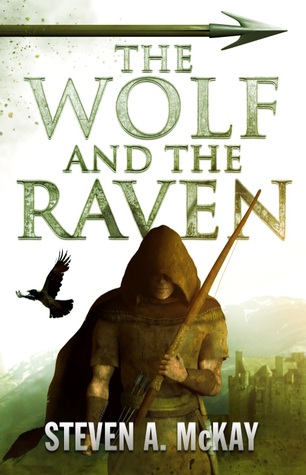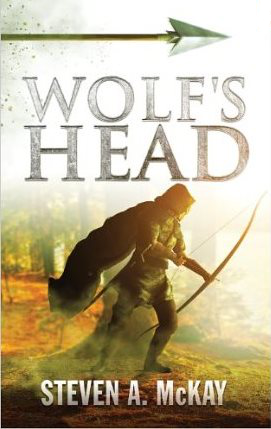Author Steven A. McKay explores how you can weave myth and magic into your historical fiction, whilst maintaining authenticity, something that is so important to the historical fiction writer.

Historical fiction is a rapidly growing genre. From books like Bernard Cornwell's Stonehenge, which focuses on prehistoric times, to Catch 22, the classic satirical novel set in the Second World War, people love to read about the past. Not just from the dry, analytical perspective of a historian though – readers want to understand what it was like for the people who actually lived back then. They want to see history through the eyes of those who were there, taste the foods, hear the sounds, experience the trials and tribulations – the horror! – of a time without wi-fi and e-books.
The problem is, though, real life isn't always that exciting. Not even for kings or assassins or a mythical hero like Robin Hood who stars in my own novels, Wolf's Head and The Wolf and the Raven.
Right from the start, I wanted to craft a realistic version of medieval life, with all the hardships and injustices the lower classes had to face back then. Although the setting had to be historically accurate, I also wanted my story to be fast-paced, action-packed and exciting - just like the legend.
However, before you think about a plot or write anything down, historical fiction demands you research your chosen period.
It seems obvious, but I'm not just talking about reading a few books dealing specifically with the events you're recreating and regurgitating what they tell you. You need to understand what the time you're describing was really like, as small things might be different to how they are now, even in the same country. What foods did they eat? What was the weather like? What clothes did they wear? What kind of weapons were available at the time? What was the foliage like? What did things cost?
You must get these things spot-on or your readers will be thrown out of the world you're trying so hard to create when they notice an anomaly. Potatoes for dinner in medieval England? Sheltering under fir-trees? Fishing for rainbow trout? No, no, no! These may seem like minor points but every author should aim for as much realism as possible when crafting their historical setting.
Once you have that realistic foundation, you can relax a little and allow your characters, fictional or otherwise, to come to life.
Everyone's heard of Robin Hood, but was he a real person? I think he was probably an amalgamation of several different heroic outlaws around which an enduring legend has been built, but how does a writer bring such a mythical figure to life? Simple: by making them act much like you or me. Give your characters feelings, failings and fears and they'll seem so much more realistic to readers. People a thousand years ago worried about many of the same, mundane things as we do nowadays: money, relationships, putting food on the table, sex, the weather, addictions etc. Bear that in mind and it shouldn't be too hard to craft characters your readers can identify with, despite the huge distance in time.
My Robin is a normal man – not a noble or superhero as later additions to the legend would have it – but placing him into a historically accurate setting meant I could amplify certain of those mythical aspects of his character without turning the book into complete fantasy. He's real, with fears and self-doubts like you and me, in a real time and place, with a real political struggle for power between great historical figures going on around him. Thanks to his preternatural skill with a longbow or sword though, Robin has, unlike his peers, the ability to face the harsh realities of medieval society head-on and influence them in his own way. This blend of mythical figure within a historically accurate setting makes him an interesting and believable hero readers can relate to and root for.
The blurring of the lines between history and myth is something each author approaches a different way. One well-known writer of Viking novels has a novel which features a ghost that occasionally appears to the protagonist, although everything else about the book is straight historical fiction. Using the supernatural or paranormal in this way, to my mind, takes the focus away from the realistic setting that you're striving to create, draws everything into the realms of fantasy and pulls your audience out of the world you're working so hard to create. Bernard Cornwell on the other hand, in his King Arthur books, made Merlin's magical powers much more ambiguous. The myth and magic was in there, but it was left to the reader to decide how much of it was real or not.

In my début novel, Wolf's Head, Will Scaflock suffers a terrible injury. His struggle to survive could have been written as an all-out fantasy scene, but I chose to write it in such a way that the reader can make up their own mind about how things transpire. This really brings the audience into your fictional world, almost letting them become the author for a while. If they want God or magic to be involved in what happens to Will that's okay. But if the reader believes the outcome is all down to his strength of character that's fine too. By not making everything explicit anything is possible.
Ultimately everyone will have their own ideas about the best way to meld historical fact with myth and legend. At the end of it all, the most important thing is telling a great story that readers enjoy. You can study your chosen era until you know it inside out, but if your characters are boring or unrealistic, and your settings drab and uninspiring, no one will want to read your book.
Build a historically accurate setting, populate it with believable characters, add a little touch of myth and legend to make things exciting, then use it all to entertain your readers and you won't go far wrong.
Steven A. McKay was born in 1977, near Glasgow in Scotland. He lives in Old Kilpatrick with his wife and two young children. His second book, The Wolf and the Raven was released on 7th April 2014, at the London Book Fair where he was part of the Amazon KDP stand. Wolf's Head is a Kindle top 20 best-seller while The Wolf and the Raven was the “War” chart number 1.
He plays lead guitar in a heavy metal band when they can find the time to meet up. Find out more about him here, read his blog here and connect with him on Twitter & Facebook.
Comments